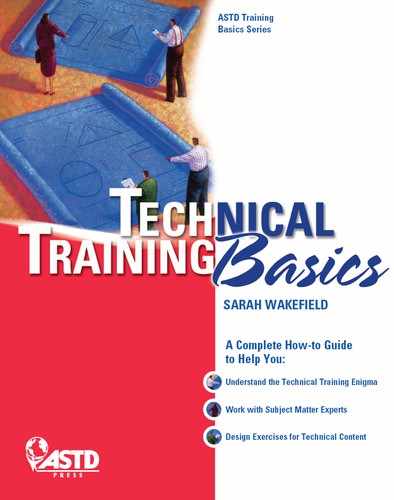Preface
When industrial accidents occur as a result of human error, it is only a matter of time before the inevitable question is asked: Where was the training?
In a world where things like safety, quality, and efficiency are essential, we cannot afford ineffective, inefficient technical training. Technical training must be done, and it must be done well in today’s business environment.
Yet, with all that said, there are few resources available that specifically discuss how to effectively develop technical training.
Technical training development is a complex, challenging, unique, misunderstood, and sometimes frustrating process. As a nontechnical course developer, your job is especially tricky: You must complete all the regular tasks of developing courseware, but you must do this using words and concepts you don’t fully understand.
I have worked with contract course developers from all different levels, including developers who were paid a premium for their impressive (on paper, at least) backgrounds. But what I have learned from this is that experience isn’t always the biggest success factor for putting together a technical course. Some of the most expensive, experienced developers have let me down—calling me one week before an assignment is due to tell me that the project is just too complicated for them, that they have never had to do anything so difficult before, and that they won’t be able to finish. Conversely, I have worked with developers fresh out of college who demonstrated specific promising skills and with a little practice were able to produce efficiently and outperform other, more experienced individuals.
I’ve noticed that the technical developers who are successful all exhibit some of the same characteristics and approaches. That is what this book is about.
Technical training requires different tactics to develop than nontechnical training. One of the biggest success factors of technical training development is being able to work effectively with your subject matter expert (SME). In addition, launching the project the right way, understanding different ways technical courses can be organized, finding the right information, designing technical exercises, and piloting a course with an SME/instructor are all important items to know. This book is intended to discuss these things and more—in a very real, specific, and readable way.
What This Book Does Not Cover
If you have never designed a training class before, this book is not for you. This book does not go into great depth on why things like the ADDIE model and adult learning are necessary; rather, it covers how to apply those concepts to a technical training project. It is expected that you already understand the basic tenets of instructional design and adult learning tactics.
Primary Audience
The primary audience of this book is anyone who develops technical training with the help of an SME. This includes training developers, instructional designers, curriculum developers, technical writers, training managers, training coordinators, content designers, and training specialists, among others.
SMEs who develop their own technical training will still be able to pull concepts from this book, but the bulk of the writing is geared toward developers who are working with an SME.
Chapter-by-Chapter Highlights
This book provides specific ideas, tips, and strategies to effectively and efficiently develop technical training, from the beginning of the project all the way through the pilot course and postcourse review. This book is loosely organized according to the course development process. Specifically, the chapters cover the following:
Chapter 1: The Technical Training Enigma describes technical training and discusses some of the differences between technical and nontechnical training. The technical organization is briefly explored.
Chapter 2: The Successful Development Team covers the roles needed for technical course development and the characteristics of an effective developer and an SME.
Chapter 3: Beginning the Technical Training Project discusses aspects related to the initial course design meeting, including why the meeting is important, who should attend, important questions to ask, and what should be accomplished.
Chapter 4: Arranging a Technical Course describes how to create a course design document. The chapter examines in detail the various options available for arranging a technical products or task-based course.
Chapter 5: Gathering Information discusses the type of information to seek and the challenges associated with gathering technical data. Potential in-house and outside sources of data are explored. The chapter analyzes tactics for maximizing information received, along with organizational systems for the technical designer.
Chapter 6: Working with Subject Matter Experts covers tangible ways to draw information out of SMEs. The chapter gives specific tips for going through edits with SMEs.
Chapter 7: Designing Classroom Exercises for Highly Technical Content provides specific examples, templates, and takeaways of exercises designed for highly technical content. The chapter also covers the importance of building a library of examples.
Chapter 8: The Pilot Class and Beyond explores development opportunities from the pilot class, helping out the SME-turned-trainer, and postcourse maintenance.
Chapter 9: Troubleshooting: Challenges and Solutions investigates different technical training challenges and provides specific and useful takeaways and solutions.
Look for These Icons
 |
What’s Inside This Chapter?Each chapter of the book begins with a preview of the topics discussed in the chapter. You can use this information as a guide for what to expect as well as a quick reference should you wish to jump to a section that interests you most. |
Think About ThisThese sections consist of specific lists, tips, and questions that will help you utilize the techniques and concepts covered in the chapter. |
|
 |
Basic RulesThese rules are short statements that encompass the important and fundamental tenets of technical training development. |
 |
NotedThese sections include important additional information that slightly digresses from the regular text. |
 |
Getting It DoneThis is the final section of each chapter. This section provides a way for you to relate the concepts and principles to your own technical training project. |
